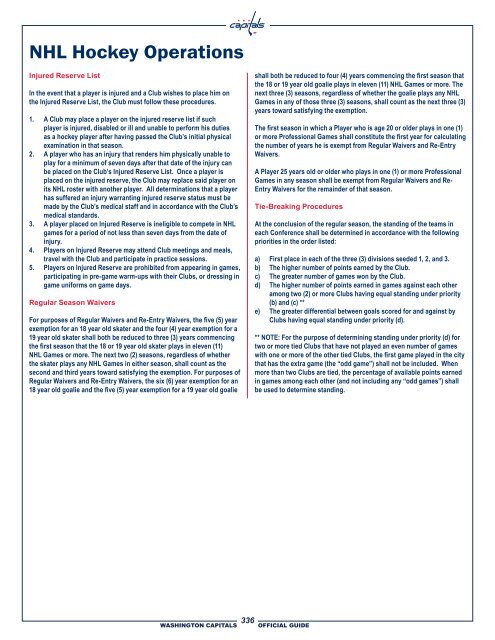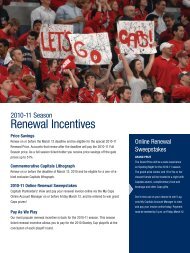Washington Capitals - NHL.com
Washington Capitals - NHL.com
Washington Capitals - NHL.com
Create successful ePaper yourself
Turn your PDF publications into a flip-book with our unique Google optimized e-Paper software.
<strong>NHL</strong> Hockey Operations<br />
Injured Reserve List<br />
In the event that a player is injured and a Club wishes to place him on<br />
the Injured Reserve List, the Club must follow these procedures.<br />
1. A Club may place a player on the injured reserve list if such<br />
player is injured, disabled or ill and unable to perform his duties<br />
as a hockey player after having passed the Club’s initial physical<br />
examination in that season.<br />
2. A player who has an injury that renders him physically unable to<br />
play for a minimum of seven days after that date of the injury can<br />
be placed on the Club’s Injured Reserve List. Once a player is<br />
placed on the injured reserve, the Club may replace said player on<br />
its <strong>NHL</strong> roster with another player. All determinations that a player<br />
has suffered an injury warranting injured reserve status must be<br />
made by the Club’s medical staff and in accordance with the Club’s<br />
medical standards.<br />
3. A player placed on Injured Reserve is ineligible to <strong>com</strong>pete in <strong>NHL</strong><br />
games for a period of not less than seven days from the date of<br />
injury.<br />
4. Players on Injured Reserve may attend Club meetings and meals,<br />
travel with the Club and participate in practice sessions.<br />
5. Players on Injured Reserve are prohibited from appearing in games,<br />
participating in pre-game warm-ups with their Clubs, or dressing in<br />
game uniforms on game days.<br />
Regular Season Waivers<br />
For purposes of Regular Waivers and Re-Entry Waivers, the five (5) year<br />
exemption for an 18 year old skater and the four (4) year exemption for a<br />
19 year old skater shall both be reduced to three (3) years <strong>com</strong>mencing<br />
the first season that the 18 or 19 year old skater plays in eleven (11)<br />
<strong>NHL</strong> Games or more. The next two (2) seasons, regardless of whether<br />
the skater plays any <strong>NHL</strong> Games in either season, shall count as the<br />
second and third years toward satisfying the exemption. For purposes of<br />
Regular Waivers and Re-Entry Waivers, the six (6) year exemption for an<br />
18 year old goalie and the five (5) year exemption for a 19 year old goalie<br />
336<br />
WASHINGTON CAPITALS OFFICIAL GUIDE<br />
shall both be reduced to four (4) years <strong>com</strong>mencing the first season that<br />
the 18 or 19 year old goalie plays in eleven (11) <strong>NHL</strong> Games or more. The<br />
next three (3) seasons, regardless of whether the goalie plays any <strong>NHL</strong><br />
Games in any of those three (3) seasons, shall count as the next three (3)<br />
years toward satisfying the exemption.<br />
The first season in which a Player who is age 20 or older plays in one (1)<br />
or more Professional Games shall constitute the first year for calculating<br />
the number of years he is exempt from Regular Waivers and Re-Entry<br />
Waivers.<br />
A Player 25 years old or older who plays in one (1) or more Professional<br />
Games in any season shall be exempt from Regular Waivers and Re-<br />
Entry Waivers for the remainder of that season.<br />
Tie-Breaking Procedures<br />
At the conclusion of the regular season, the standing of the teams in<br />
each Conference shall be determined in accordance with the following<br />
priorities in the order listed:<br />
a) First place in each of the three (3) divisions seeded 1, 2, and 3.<br />
b) The higher number of points earned by the Club.<br />
c) The greater number of games won by the Club.<br />
d) The higher number of points earned in games against each other<br />
among two (2) or more Clubs having equal standing under priority<br />
(b) and (c) **<br />
e) The greater differential between goals scored for and against by<br />
Clubs having equal standing under priority (d).<br />
** NOTE: For the purpose of determining standing under priority (d) for<br />
two or more tied Clubs that have not played an even number of games<br />
with one or more of the other tied Clubs, the first game played in the city<br />
that has the extra game (the “odd game”) shall not be included. When<br />
more than two Clubs are tied, the percentage of available points earned<br />
in games among each other (and not including any “odd games”) shall<br />
be used to determine standing.















